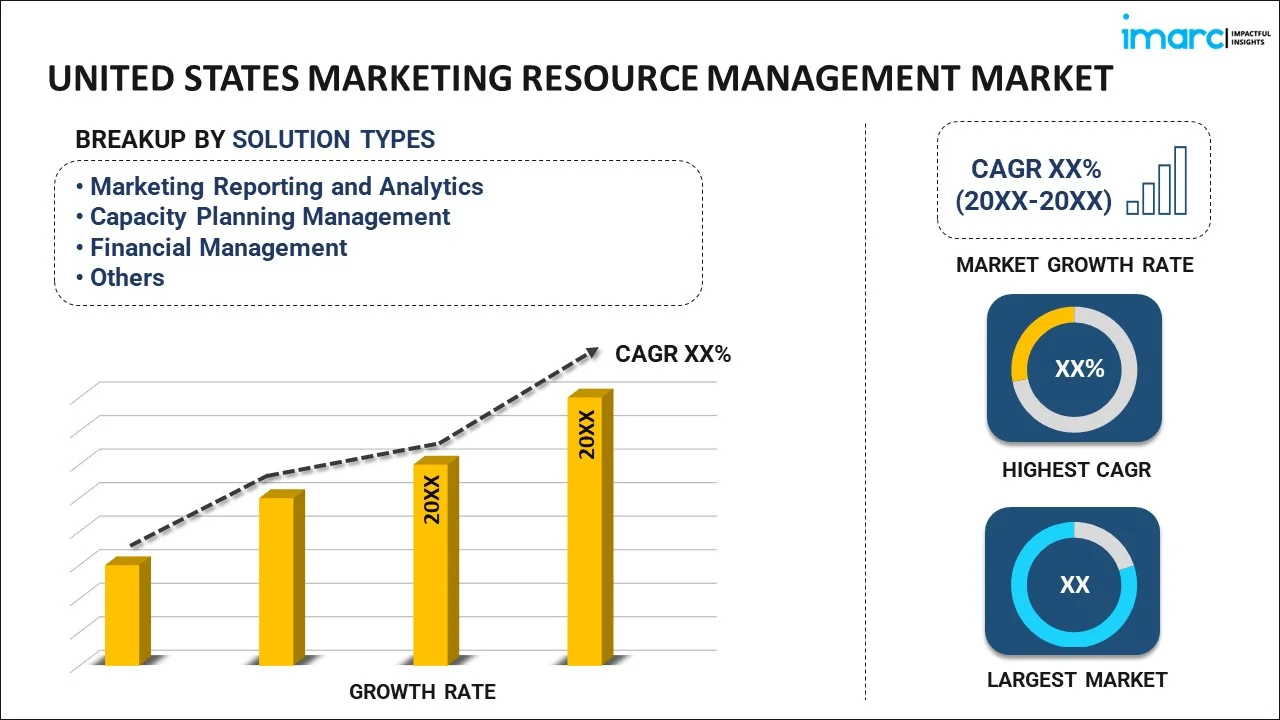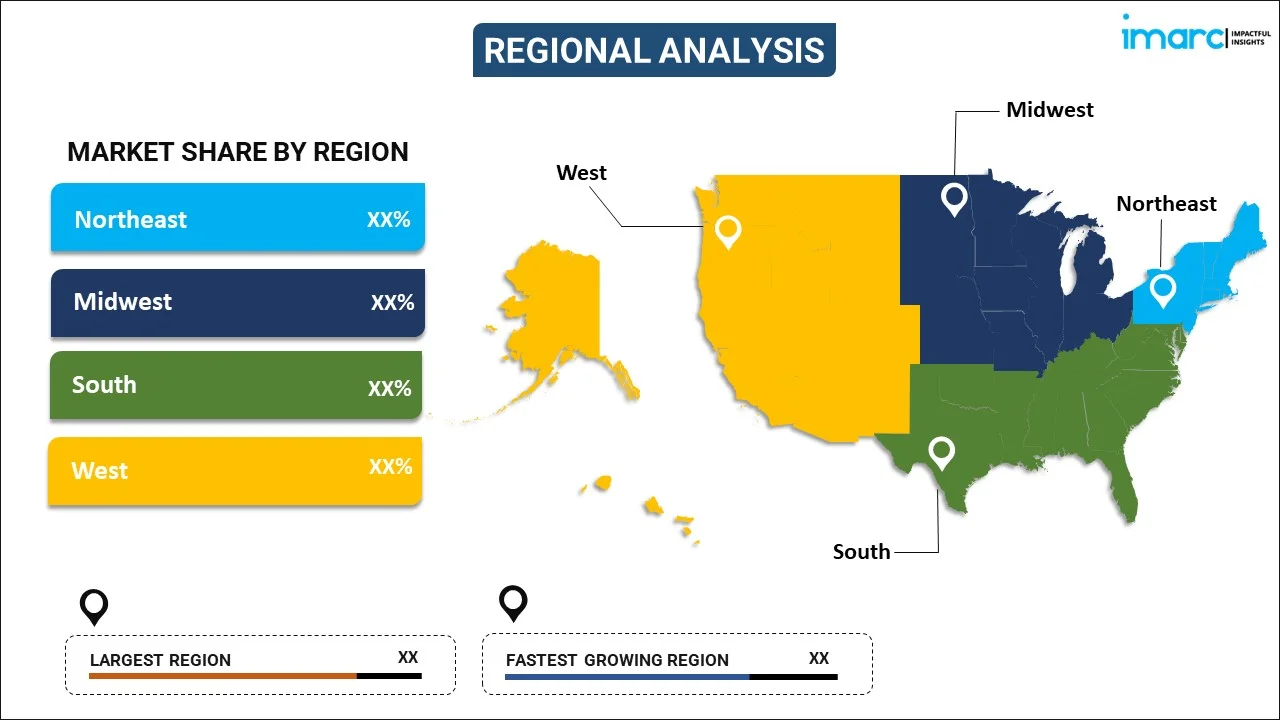
United States Marketing Resource Management Market Report by Solution Type (Marketing Reporting and Analytics, Capacity Planning Management, Financial Management, Creative Production Management, Brand and Advertising Management, Marketing Asset Management, and Others), Deployment Type (On-premises, Cloud-based), Enterprise Size (Large Enterprises, Small and Medium-sized Enterprises), Industry Vertical (Media and Entertainment, Retail, BFSI, Healthcare, Consumer Goods, Automotive, Manufacturing, Apparel, and Others), and Region 2025-2033
Market Overview:
United States marketing resource management market size reached USD 1.0 Billion in 2024. Looking forward, IMARC Group expects the market to reach USD 2.5 Billion by 2033, exhibiting a growth rate (CAGR) of 10.7% during 2025-2033. The increasing demand for cloud services and big data analytics, the rising need for more reliable and scalable data processing and storage facilities and stringent regulatory compliance represent some of the key factors driving the market.
|
Report Attribute
|
Key Statistics
|
|---|---|
|
Base Year
|
2024 |
|
Forecast Years
|
2025-2033
|
|
Historical Years
|
2019-2024
|
| Market Size in 2024 | USD 1.0 Billion |
| Market Forecast in 2033 | USD 2.5 Billion |
| Market Growth Rate (2025-2033) | 10.7% |
Marketing resource management (MRM) is a cloud-based software application adopted by organizations to efficiently centralize and manage their marketing operations. This tool facilitates the organization in consolidating brand compliance, streamlining marketing workflows, and monitoring return on investment (ROI). Its core functions encompass budgeting, planning, and the comprehensive management of marketing assets, content, and projects. Moreover, it plays a pivotal role in evaluating the effectiveness of marketing communications and initiatives. In line with this, due to these advantageous features, marketing resource management sees widespread utilization across diverse industries, including but not limited to banking, financial services, insurance (BFSI), information technology (IT), healthcare, retail, and automotive sectors. Consequently, it is gaining extensive traction across the United States.
United States Marketing Resource Management Market Trends:
The United States marketing resource management market stands at the forefront of innovative solutions for streamlined and centralized marketing operations within various industries. MRM, a cloud-based software application, is embraced by organizations across sectors such as banking, financial services, insurance (BFSI), information technology (IT), healthcare, retail, and automotive. Its significance lies in the effective unification of brand compliance, marketing workflows, and the meticulous tracking of return on investment (ROI). This dynamic tool excels in budgeting, planning, and overall management of marketing assets, content, and projects. It serves as a catalyst in assessing and optimizing the impact of marketing communications and initiatives. In the landscape of U.S. marketing, MRM plays a pivotal role in enhancing efficiency and ensuring a cohesive approach to brand management. As organizations prioritize integrated marketing strategies, the demand for marketing resource management solutions has witnessed a notable upswing. The market's adaptability to diverse industries and its ability to deliver quantifiable results underscore its relevance in the rapidly evolving and competitive American business environment. The United States marketing resource management market is expected to fuel over the forecasted period.
United States Marketing Resource Management Market Segmentation:
IMARC Group provides an analysis of the key trends in each segment of the market, along with forecasts at the country level for 2025-2033. Our report has categorized the market based on solution type, deployment type, enterprise size, and industry vertical.
Solution Type Insights:

- Marketing Reporting and Analytics
- Capacity Planning Management
- Financial Management
- Creative Production Management
- Brand and Advertising Management
- Marketing Asset Management
- Others
The report has provided a detailed breakup and analysis of the market based on the solution type. This includes marketing reporting and analytics, capacity planning management, financial management, creative production management, brand and advertising management, marketing asset management, and others.
Deployment Type Insights:
- On-premises
- Cloud-based
A detailed breakup and analysis of the market based on the deployment type have also been provided in the report. This includes on-premises and cloud-based.
Enterprise Size Insights:
- Large Enterprises
- Small and Medium-sized Enterprises
The report has provided a detailed breakup and analysis of the market based on the enterprise size. This includes large enterprises and small and medium-sized enterprises.
Industry Vertical Insights:
- Media and Entertainment
- Retail
- BFSI
- Healthcare
- Consumer Goods
- Automotive
- Manufacturing
- Apparel
- Others
A detailed breakup and analysis of the market based on the industry vertical have also been provided in the report. This includes media and entertainment, retail, BFSI, healthcare, consumer goods, automotive, manufacturing, apparel, and others.
Regional Insights:

- Northeast
- Midwest
- South
- West
The report has also provided a comprehensive analysis of all the major regional markets, which include Northeast, Midwest, South, and West.
Competitive Landscape:
The market research report has also provided a comprehensive analysis of the competitive landscape. Competitive analysis such as market structure, key player positioning, top winning strategies, competitive dashboard, and company evaluation quadrant has been covered in the report. Also, detailed profiles of all major companies have been provided.
United States Marketing Resource Management Market Report Coverage:
| Report Features | Details |
|---|---|
| Base Year of the Analysis | 2024 |
| Historical Period | 2019-2024 |
| Forecast Period | 2025-2033 |
| Units | Billion USD |
| Scope of the Report | Exploration of Historical and Forecast Trends, Industry Catalysts and Challenges, Segment-Wise Historical and Predictive Market Assessment:
|
| Solution Types Covered | Marketing Reporting and Analytics, Capacity Planning Management, Financial Management, Creative Production Management, Brand and Advertising Management, Marketing Asset Management, Others |
| Deployment Types Covered | On-premises, Cloud-based |
| Enterprise Sizes Covered | Large Enterprises, Small and Medium-sized Enterprises |
| Industry Verticals Covered | Media and Entertainment, Retail, BFSI, Healthcare, Consumer Goods, Automotive, Manufacturing, Apparel, Others |
| Regions Covered | Northeast, Midwest, South, West |
| Customization Scope | 10% Free Customization |
| Post-Sale Analyst Support | 10-12 Weeks |
| Delivery Format | PDF and Excel through Email (We can also provide the editable version of the report in PPT/Word format on special request) |
Key Questions Answered in This Report:
- How has the United States marketing resource management market performed so far and how will it perform in the coming years?
- What has been the impact of COVID-19 on the United States marketing resource management market?
- What is the breakup of the United States marketing resource management market on the basis of solution type?
- What is the breakup of the United States marketing resource management market on the basis of deployment type?
- What is the breakup of the United States marketing resource management market on the basis of enterprise size?
- What is the breakup of the United States marketing resource management market on the basis of industry vertical?
- What are the various stages in the value chain of the United States marketing resource management market?
- What are the key driving factors and challenges in the United States marketing resource management?
- What is the structure of the United States marketing resource management market and who are the key players?
- What is the degree of competition in the United States marketing resource management market?
Key Benefits for Stakeholders:
- IMARC’s industry report offers a comprehensive quantitative analysis of various market segments, historical and current market trends, market forecasts, and dynamics of the United States marketing resource management market from 2019-2033.
- The research report provides the latest information on the market drivers, challenges, and opportunities in the United States marketing resource management market.
- Porter's five forces analysis assist stakeholders in assessing the impact of new entrants, competitive rivalry, supplier organization, buyer organization, and the threat of substitution. It helps stakeholders to analyze the level of competition within the United States marketing resource management industry and its attractiveness.
- Competitive landscape allows stakeholders to understand their competitive environment and provides an insight into the current positions of key players in the market.
Need more help?
- Speak to our experienced analysts for insights on the current market scenarios.
- Include additional segments and countries to customize the report as per your requirement.
- Gain an unparalleled competitive advantage in your domain by understanding how to utilize the report and positively impacting your operations and revenue.
- For further assistance, please connect with our analysts.
 Inquire Before Buying
Inquire Before Buying
 Speak to an Analyst
Speak to an Analyst
 Request Brochure
Request Brochure
 Request Customization
Request Customization




.webp)




.webp)












